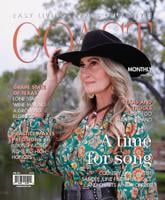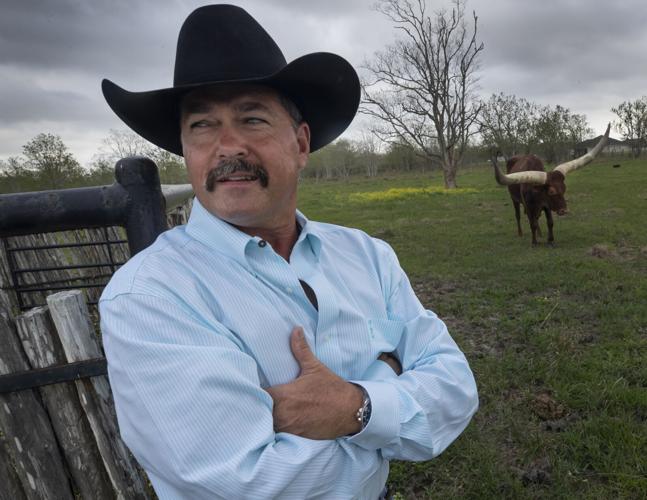
Algoa resident Mark Bennett spent more than 20 years as a Professional Rodeo Cowboys Association bullfighter. Last year, he was inducted into the All Cowboy & Arena Champions Hall of Fame.
He spends his time either boot-clad with his 1,600-pound Watusi steers in Algoa or sporting a pair of flip-flops dipping his boat into the Gulf. The life of retired rodeo star Mark Bennett is a shot of whiskey with salt around the rim.
This self-proclaimed “Saltwater Cowboy” wears the title well.
Donning his signature Hawaiian shirt with more-near Western wear, Bennett spent his 20s and 30s touring the country from the late ’80s to 2011 to entertain crowds of rodeo enthusiasts.
Fighting bulls isn’t for the faint of heart, and most athletes hang up their boots before they’re 30. But Bennett couldn’t stay away, retiring at age 42 with 25 years under his elaborate belt buckle.
“In the sport of fighting bulls … if you’re not good at it, the bulls are gonna let you know,” Bennett quipped. “It’s almost like playing professional sports. If you make it up into your 40s, it’s an exception. I’m very fortunate that I did get to fight bulls for so long.”

Mark Bennett, a retired professional bullfighter, spent his 20s and 30s touring the country to entertain crowds of rodeo enthusiasts.
RODEO ROCK STAR
While performing in 28 states before his rodeo retirement, Bennett found the most fervent fans actually didn’t live in the South.
“Where they treated us like rock stars was the East Coast, all up there in the New York, Maine, New Hampshire area,” he said. “It’s a novelty to them.
“I mean, the minute I got off a plane, they treated me like a rock star. People would arrive three hours early to see us offload the bulls — just to see the bulls. It blew my mind the first time I went there.”
Seeing men clad in cowboy hats and attire is nothing new for rodeo-goers in Southern states, Bennett said. Attendees up north would eagerly wait months for the rodeo to bring rural fun to their cities, he said.

Mark Bennett’s championship belt buckles.

A photograph of Mark Bennett in his bullfighting days.
“After 9/11, when they shut down the airlines for two weeks, the first day they opened it up I was on a plane,” he remembered. “I left for Buffalo, New York, for a show. The second night was sold out because, after 9/11, everybody had been inside sulking for two weeks and they were ready to get out.”
Becky Bennett had a hard time keeping the same level of composure required of her husband in the arena, recalled their 15-year-old daughter, Baylee. Baylee remembers being able to go backstage at the rodeos, giving the then-toddler an air of exclusivity and pride. She grew up in and around rodeos.
“I remember when I was little, I was like, ‘Dad is a professional,’” Baylee said. “I remember because Dad was getting older, so my mom was getting nervous because he was one of the oldest ones.”
Becky jokingly attributes her back pain to four decades of air-steering her husband away from rampaging bulls from her seat in the stands.
“It never worked,” she joked.
“I’m very fortunate to have walked away from it,” Mark added.
EXTRA-LARGE LONGHORNS
A few years before metaphorically hanging up his rodeo boots, Mark decided to add a bit of rodeo to his backyard in the form of two six-month-old Watusi steers.
“They’re probably some of the only Watusi cattle in all of Galveston County,” Mark said with palpable pride, speaking about Rojo and Rio.

Mark Bennett offers a treat to Rojo, one of his two Ankole-Watusi bulls.
Along with thicker, sometimes longer, horns, Watusi cattle can grow to be about a hundred pounds heavier than a Texas longhorn. Gawkers often ask Bennett what kind of longhorns Rojo and Rio are, as the two are commonly mistaken for their Texan cousins.
“The blood is also in the Watusi’s horn, so if something were to happen to the horn, they could bleed out,” Becky said. “It’s like a radiator.”
Bennett bought the pair from a Houston-area breeder 15 years ago, making Rojo and Rio as old as their “sibling” Baylee.
The aptly named Rojo wears a rich, coffee-red coat, while his brother Rio is a live Jackson Pollock painting. The mellow behemoths meander about their pasture peacefully most of the day. They weigh from 1,500 to 1,600 pounds, their horns are more than 9 feet wide and 25 inches around at the base. But they’re mostly a quiet, social pair — immediately hoofing their way toward the fence when humans approach.
NOT KIDDING
“Baylee would hardly ever walk out in that pasture until we started building that goat pen,” Mark said, alluding to the pen he built with Baylee to house her first interest in rodeo life.
Mark never pressured Baylee into barrel racing, showing animals or any other recreational rodeo activity. But after sitting inside during the pandemic, she became restless.
Baylee was in fine arts, she excelled in her choir, but two-and-a-half years ago, she asked her father to buy her a show goat to raise.
“And Dad was like, ‘What?’” she remembered.
The Bennetts knew absolutely nothing about goats at the time, but set out to educate themselves before adding a kid to the family.
With the cheapest goat the Bennetts could find, Baylee entered a show at the Galveston County Fair & Rodeo and won third — over animals worth thousands of dollars.
“All the livestock animals are treated like bodybuilders,” she explained. “Bodybuilders are all high protein and exercising; I’m like their personal trainer. We go to a show and we get placed by weight classes. My first year, my goat was 120 pounds. And that’s the max weight allowed in a show in Galveston County.”
“Dog shows are about genetics, it’s about structure and how they move. It’s kind of the same thing with goats, but they kind of put the market spin on it. So, livestock judging is imagining what they look like on a hook.”
Rio and Rojo now live with new pasture pals, Boer goats Razor and Rambo. The confluence of bleats and occasional moos creates a cross-species quartet befitting any rodeo. An ever-curious Labrador next door regularly joins the chorus when any of his neighbors stir.
Show goats Razor and Rambo are far more rambunctious and lively than their steer siblings. Razor uses affection to sneak a nibble of clothing, or whatever he can get his mouth on, while Rambo seems more interested in climbing the bars of his pen.
“I love animals, and some people are like, ‘You are so cruel to do this,’” Baylee said. “But that’s what they’re for. They think I’m a cold-hearted person, but I do cry, I do care, I do get sad. In the end, it’s what I love to do.”
ROPED BACK IN
Mark was out of bullfighting for 10 years, which felt like 10 minutes to him, when his daughter’s spark of inspiration rekindled his own interest.
“I had been out of fighting bulls for 10 years and out of rodeos, and, all of a sudden, boom! I’m back in it, but from a different angle,” Mark said. “There was a little lull, but I’m excited again. I had almost that same feeling when I was going to rodeos.
“I’m just as equally excited; I get all worked up. And I get that same intensity as I did when I was fighting bulls.”
While loading up the trailer at 2 a.m. to leave for weekend rodeos inspires comparable feelings of joy and anticipation for Mark, watching his daughter do what she loves — and earn accolades along the way — fills him with far more pride than when he was on the rodeo circuit, he said.
“She’s won more belt buckles in two-and-a-half years than I won in my whole 25-year career,” he said. “She’s won 21 buckles.”
Baylee spends seven to eight months with each goat, preparing to show them off at rodeos across the state. Her next goal is to win grand champion.
“We’ve learned a lot in these two-and-a-half years of this goat thing,” Mark said. “If you would’ve asked me five years ago, I wouldn’t know a good goat from a bad goat. Now, after being around them, I can see the differences.”
SALT ON THE RIM
Boating and fishing provide quieter alternatives to the Bennetts’ list of outdoor pastimes. Their surf-and-turf mindset led the Pasadena natives to seek land in Galveston County, where they could have steer 20 miles from the pier.
“Even when I was fighting bulls, I always wore Hawaiian shirts,” he said. “I’ve always liked the coast and the coastal lifestyle, but I rodeoed, too. Everybody knew when they saw a cowboy with a Hawaiian shirt, it was Mark Bennett.”
While the Bennetts aren’t tending to their two goats, Watusi steer or one dog, they’re somewhere in the Gulf of Mexico, likely fishing. And, as she’s swift to point out, Becky holds the title of the Bennetts’ best angler. She’s completely undaunted by reeling in sharks, something for which the Bennetts regularly enter tournaments.
“I’m either in flip-flops or cowboy boots, bottom line,” Mark said. “I haven’t owned a pair of tennis shoes for 40 years. It’s either cowboy boots or flip-flops, man.” 







(0) comments
Welcome to the discussion.
Log In
Keep it Clean. Please avoid obscene, vulgar, lewd, racist or sexually-oriented language.
PLEASE TURN OFF YOUR CAPS LOCK.
Don't Threaten. Threats of harming another person will not be tolerated.
Be Truthful. Don't knowingly lie about anyone or anything.
Be Nice. No racism, sexism or any sort of -ism that is degrading to another person.
Be Proactive. Use the 'Report' link on each comment to let us know of abusive posts.
Share with Us. We'd love to hear eyewitness accounts, the history behind an article.